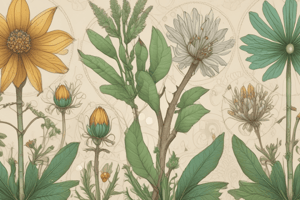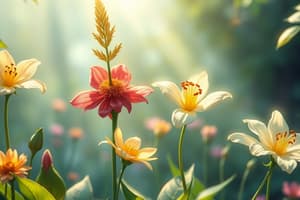Podcast
Questions and Answers
Which of the following categories includes organisms that have both sexual and asexual stages, and are non-motile?
Which of the following categories includes organisms that have both sexual and asexual stages, and are non-motile?
- Green algae
- Gymnosperms (correct)
- Brown algae
- Red algae (correct)
How many examples listed possess sporangia?
How many examples listed possess sporangia?
- 6 (correct)
- 7
- 4
- 8
Which type of organisms have a free living gametophyte stage?
Which type of organisms have a free living gametophyte stage?
- Only pteridophytes
- Gymnosperms and angiosperms
- Only bryophytes
- Algae and bryophytes (correct)
How many organisms listed are motile during their asexual stage?
How many organisms listed are motile during their asexual stage?
How many examples provided have dependent sporophytes?
How many examples provided have dependent sporophytes?
Which of these organisms include only homosporous plants?
Which of these organisms include only homosporous plants?
Which organisms possess photosynthetic sporophytes and archegonia?
Which organisms possess photosynthetic sporophytes and archegonia?
Which of the following contains heterosporous organisms?
Which of the following contains heterosporous organisms?
How many examples listed are considered to have a sporangia-bearing diploid stage?
How many examples listed are considered to have a sporangia-bearing diploid stage?
What is the total number of organisms that are motile during their asexual stage among the Brown algae?
What is the total number of organisms that are motile during their asexual stage among the Brown algae?
Study Notes
Life Cycles in Plants
- Examples include Volvox, Spirogyra, Porphyra, Gracilaria, Marchantia, Sphagnum, Polytrichum, Pteris, Ginkgo, Cedrus, and Pea.
- Zygotic meiosis occurs in four examples, all from algae.
- Four examples exhibit a haplontic life cycle, again all algae.
- Haplodiplontic life cycles are present in four organisms, specifically bryophytes and pteridophytes.
- Three entities represent a diplontic life cycle, including gymnosperms and angiosperms.
- Seven examples indicate embryophyta; all except algae undergo zygotic mitosis.
Additional Plant Classes
- Ulothrix, Gelidium, Dryopteris, Adiantum, Cycas, Sequoia, Porphyra, Fucus, Funaria, Equisetum, and Hibiscus include diverse plants.
- Sporogenic meiosis occurs in eight plants, including all except algae.
- Only three algae show zygotic meiosis, excluding Fucus.
- Six entities classify as tracheophyta, encompassing pteridophytes, gymnosperms, and angiosperms.
- Spermatophyta (gymnosperms and angiosperms) totals three entities.
- Cryptogamae include algae, bryophytes, and pteridophytes with a total of eight examples.
- Four examples show haplodiplontic characteristics among bryophytes and pteridophytes.
Specific Plant Features
- The organisms Spirogyra, Ulothrix, Gracilaria, Dictyota, Polytrichum, Pteris, Selaginella, Sequoia, Banyan, Salvinia, and Sphagnum highlight various life forms.
- Two bryophytes show haplodiplontic haploid characteristics.
- No seed-bearing cryptogams are identified.
- Two haploid plants with archegonium belong to bryophytes.
- Two entities showcasing diplontic embryophyta are gymnosperms and angiosperms.
- Pteridophyta presents three haplodiplontic characteristics.
- No organisms possess haploid features while exhibiting a diplontic life cycle.
Plant Life Cycle Variations
- Chlorella, kelp, ectocarpus, Polytrichum, Cedrus, Pinus, Lycopodium, Ginkgo, bean, wheat, Marchantia, Udorina, Fucus, and Polysiphonia display varied life cycles.
- Six entities exhibit a diplontic life cycle, including gymnosperms, angiosperms, and Fucus.
- Six examples reveal haplodiplontic nature among certain algae, bryophytes, and pteridophytes.
- Five plants with sporic meiosis that bear seeds include gymnosperms and angiosperms.
- Sporogenic meiosis with haploid plants accounts for seven examples, comprising algae and bryophytes, excluding Fucus.
- Gymnosperms present three diploid plants with archegonium.
- Five phanerogamae produce pollen grains, including gymnosperms and angiosperms.
- Six main plant bodies consist of sporophytes among gymnosperms, angiosperms, and pteridophytes.
Sporophyte and Gametophyte Presence
- Examples include Salvia, Salvinia, Porphyra, Pteris, Selaginella, Ectocarpus, Cycas, Pinus, Chlamydomonas, Spirogyra, and Gracilaria.
- The main plant body as a sporophyte occurs in six entities including gymnosperms, angiosperms, and pteridophytes.
- Five examples represent the main plant body as gametophytes, including algae and bryophytes.
- Three haplodiplontic plants are classified within bryophytes and pteridophytes.
- Five examples show dependent sporophytes from bryophytes and algae.
- Six organisms have photosynthetic sporophytes.
- Five entities reflect dependent gametophytes including heterosporous pteridophytes, gymnosperms, and angiosperms.
Diversity in Plant Characteristics
- Ulothrix, Chara, Kelp, Fucus, Porphyra, Gelidium, Marchantia, Funaria, Psilotum, Dryopteris, Cycas, Cedrus, Sugarcane, and Mustard showcase various features.
- One example is identified as a conifer.
- Homosporous characteristics are noted in ten organisms, including algae, bryophytes, and pteridophytes.
- Six examples bear chl b.
- Fourteen organisms possess chl a.
- Two green algae are haplontic and exhibit chl b.
- Six root-bearing plants include pteridophytes, gymnosperms, and angiosperms.
- Eight entities express a motile sexual stage, increasing to nine with Cycas.
Phytochemical and Structural Characteristics
- Chlamydomonas, Chara, Ginkgo, Lycopodium, Sunflower, China Rose, Gelidium, Gracilaria, Fucus, Ficus, Dictyota, Marchantia, Psilotum, Udorina, and Azolla are discussed.
- Eleven examples possess both chlorophyll a and b, excluding brown and red algae.
- Non-motile sexual and asexual stages are found in five examples including red algae, gymnosperms, and angiosperms.
- Free-living gametophytes derive from algae and bryophytes, totaling ten.
- Four organisms express both photosynthetic sporophytes and archegonia within pteridophytes and gymnosperms.
- Five entities exhibit motile asexual stages including green and brown algae.
- Seven examples show dependent sporophytes in algae and bryophytes.
- Six entities have sporangia present, including gymnosperms, angiosperms, and pteridophytes.
Sporangial Characteristics
- Spirogyra, Cladophora, Ectocarpus, Salvinia, Selaginella, Sphagnum, Polychium, Polysiphonia, Papaya, Castor, Pinus, Cedrus, Dictyota, and Udorina illustrate distinct features.
- Eight organisms are homosporous, including algae, bryophytes, and most pteridophytes.
- Six examples are heterosporous, including some gymnosperms, angiosperms, and pteridophytes.
- Four organisms demonstrate heterosporous and seed-bearing characteristics, notably gymnosperms and angiosperms.
- Four sporangia-bearing diploid plants belong to pteridophytes, gymnosperms, and angiosperms.
- Four entities showcase sporophyll presence within pteridophytes and gymnosperms.
- Non-motile sexual stages are recognized in five examples, including red algae, gymnosperms, and angiosperms.
Studying That Suits You
Use AI to generate personalized quizzes and flashcards to suit your learning preferences.
Related Documents
Description
This quiz tests your knowledge of life cycles in different plant species, including algae, bryophytes, pteridophytes, gymnosperms, and angiosperms.




